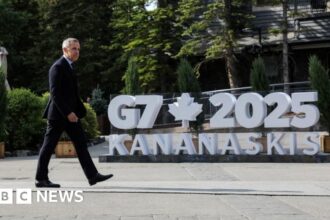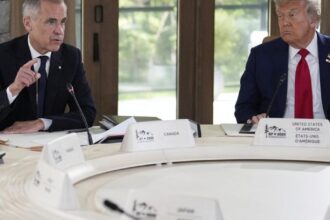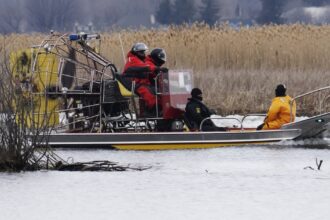The diplomatic balancing act has begun. As Canada prepares to host the G7 summit in 2025, a peculiar shadow looms over the planning committees and policy briefings: the potential return of Donald Trump to the White House. His surprising political resurrection and commanding lead in Republican primaries has forced Canadian officials to confront a delicate strategic question that few would have anticipated just months ago.
The timing couldn’t be more politically charged. If the electoral winds blow as current polls suggest, Canada may find itself hosting a summit with a newly reinstalled President Trump—a leader whose first term was characterized by diplomatic unpredictability and a fundamental reshaping of America’s approach to its oldest alliances. The question that haunts Ottawa’s corridors isn’t whether to prepare for this possibility, but how to do so without appearing to anticipate American electoral outcomes.
“It’s the diplomatic equivalent of walking on eggshells,” explains Dr. Martin Beauregard, professor of international relations at McGill University. “Canada must simultaneously prepare for every possible U.S. administration while appearing completely neutral about American democratic processes.”
Behind closed doors, however, sources suggest that Canadian officials are developing what amounts to a dual-track planning process. One follows conventional diplomatic protocols for engaging with the Biden administration, while another quietly games out scenarios for managing a G7 with Trump at the table—a prudent approach given what’s at stake.
Trump’s first presidential term featured moments of significant tension with Canada. His administration’s renegotiation of NAFTA, imposition of tariffs on Canadian aluminum and steel under dubious “national security” justifications, and public criticism of Prime Minister Trudeau created unprecedented strain between the neighboring countries. As one former Canadian diplomat told me, “There was a fundamental shift in how we approached the relationship—from presumed partnership to careful management.”
The 2018 G7 summit in Charlevoix, Quebec provides a cautionary tale. Trump abruptly withdrew his endorsement of the joint communiqué after departing early, attacking Trudeau on social media as “dishonest and weak.” Canadian officials have not forgotten this diplomatic rupture, nor its implications for hosting responsibilities.
What might a Trump-influenced G7 look like in 2025? The summit could become a stage for his administration’s priorities: bilateral deal-making rather than multilateral consensus, skepticism toward climate initiatives, and renewed economic nationalism. For Canada, this presents both challenges and opportunities.
“Canada actually has a playbook from the first Trump term,” notes foreign policy analyst Rebecca Davidson. “They learned to appeal to specific U.S. interests rather than shared values, to engage economic advisors and state-level officials when White House relationships became strained, and to build resilient diplomatic channels that could weather presidential volatility.”
The agenda-setting power of the host nation provides Canada with modest leverage. By structuring discussions around areas of potential agreement—perhaps border security, critical minerals, or North American economic competitiveness—Canadian officials could create space for productive engagement even within a potentially fractious summit.
Preparations must also account for the broader geopolitical landscape. Relations between G7 members and China have deteriorated significantly since Trump’s first term. Russia remains isolated following its invasion of Ukraine. These evolving dynamics may create new alignment opportunities, even among leaders with divergent styles and priorities.
What makes this situation particularly complex is the need to maintain productive relations with the current administration while preparing for its potential replacement. Any perception that Canada is hedging its bets could undermine the trust necessary for effective diplomacy.
The business community is watching closely. Canadian industries that weathered the turbulence of Trump’s first term—from automotive manufacturing to agriculture—are quietly developing their own contingency plans. As one industry association executive put it, “We’re preparing for any outcome while hoping for stability.”
Canadian officials will never acknowledge their Trump-specific preparations publicly. Diplomatically, they cannot. But the responsible course demands readiness for all scenarios, especially those that might fundamentally alter the international order that the G7 was created to uphold.
Perhaps the most challenging aspect of this preparation is its necessarily incomplete nature. Trump 2.0, should it materialize, may differ significantly from his first administration. New advisors, evolved priorities, and a changed world could produce different approaches to international forums like the G7.
As Canadians prepare to welcome the world’s most powerful economies to our shores in 2025, the planning reflects a deeper truth about modern diplomacy: in an age of political volatility, the ability to adapt may prove more valuable than any specific strategy.
The elephant is indeed in the room. Canadian officials can’t acknowledge its presence, but they must nevertheless carefully navigate around it—measuring the space it might occupy, anticipating its movements, and preparing for either its arrival or its absence. In diplomacy, as in politics, preparation isn’t just prudent—it’s essential.
What remains to be seen is whether this delicate dance will yield a productive summit, regardless of who sits at the table representing our closest ally and largest trading partner. For Canada, that may be the true measure of diplomatic success in these uncertain times.

























